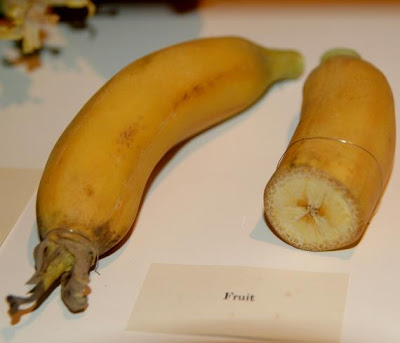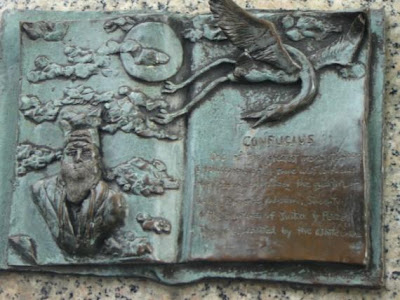That's what Susan Rossi-Wilcox, curatorial associate at the Harvard Museum of National History, calls The Glass Flowers, a collection of botanical models used for teaching. These highly realistic glass botanical models are more formally known as The Ware Collection of Blaschka Glass Models of Plants.
 |
| Image courtesy of curious expeditions/flickr. |
Leopold Blaschka and his son, Rudolf, were commissioned by the founder of Harvard's Botanical Museum, Dr. George Lincoln Goodale. Dr. Goodale wanted them for students, since real plants have limited value for teaching because of their seasonal nature and short flowering periods. At the time, only wax or papier-maché models were available, and these did not serve the purpose well.
 |
| Leopold Blaschka |
 |
| Rudolf Blaschka Images of both men courtesy of Journal of Antiques. |
Dr. Goodale was familiar with the Blaschkas' work because they had a business making glass models of invertebrates, some of which were in the Harvard Museum of Comparative Zoology. But while the glass flowers are unique and were specially made for Harvard, the invertebrates were mass manufactured and once sold through Ward's Natural Science Establishment catalog. Some of them sold for only 50¢, which in the late 1800s was considered expensive.
 |
| Ercolania Pancerii (nudibranch), a relative of the jellyfish. Image courtesy Harvard Museum of Comparative Zoology. |
 |
| A jellyfish. |
Besides the Blaschka invertebrates at Harvard, there are others at the Boston Museum of Science, the Corning Museum of Glass, Cornell University, and the Harvard Museum of Natural History, just to name some places in the U.S. These models were important before the advent of underwater photography and the development of decent facilities capable of housing creatures for study.
 |
| A sea anemone. Image courtesy the Harvard Museum of Comparative Zoology. |
 |
| Octopus. Image courtesy of Jon Chase/Harvard Education Gazette. |
The Blaschkas, who came from a long line of glassmakers and jewelers going back to the 15th century, initially signed a ten-year contract, and agreed to produce flowers half-time so they could continue their invertebrate business. They ended up producing glass flora from 1887 until 1936 from their studio in Hosterwitz, Germany (near Dresden); Rudolf carried on the project after his father died. The project was financed by Mary Lee Ware, a former student, and her mother Elizabeth Ware as a memorial to Dr. Charles Eliot Ware.
 |
| A glass bouquet given to the Wares by Leopold in 1889. Image courtesy of Journal of Antiques. |
The ten-year period that had been agreed upon made the selection of plants to replicate a serious consideration. Some plants were sent to the Blaschkas to be cultivated in their own garden for reference. Many of the plants on the list were in nearby botanical gardens and greenhouses.
 |
| Panic grass. |
 |
| Echinocreus Engelmannii of the cactus family. This image and one above from Journal of Antiques. |
But eventually the Blaschkas needed to see and study tropical plants, so in 1892 Rudolf traveled to the Caribbean and various parts of the U.S. to view plants, make drawings and notes on colors, and collect what he could. He made a second trip in 1895, but the trip was made short by the death of his father.
 |
| Image courtesy of Curious Expeditions/flickr. |
 |
| Devil's bit with butterfly. Image courtesy of above. |
While some of the models are made of colored glass, many are "cold painted" with a thin wash of colored glass or metal oxide applied and heated until fused. The painted ones are varnished. Some of the parts are glued together, and some of the stems have wire armatures within.
 |
| A glass banana. |
The pieces have suffered over time. Vibrations from the 120,000+ visitors annually, and ultraviolet light (despite efforts to block it) have damaged and stressed some pieces. There's also been some problem with glass corrosion, a process caused by a problem in the chemical composition of the original
glass formula, usually an inadequate amount of calcium oxide.
 |
| Bottle with glass disease. Image courtesy of Wikipedia. |
Glass disease, as this is called, occurs when a piece is exposed to higher levels of humidity. This causes the alkalis in the glass to remain water soluble, and the salts hydrate and leach out of the glass. Once the humidity is lowered, they form a crust. They have undergone restoration, and are displayed in controlled humidity settings.
 |
| Glass disease on the surface of a glass leaf from a model of an apple branch. Image courtesy of Kris Snibbe/ Harvard Education Gazette. |
There are approximately 4,400 of the Blaschka glass flowers. The Museum has organized displays, including a special section on plants and insects showing the different processes of pollination. The work of the Blaschkas is still touted to surpass all modern models. Their glass pieces are an amazing instance of Victorian craftsmanship.
 |
| Image courtesy Curious Expeditions/flickr. |
***************
Unless otherwise noted, image courtesy of the Harvard Museum of Natural History.
*******************************




































